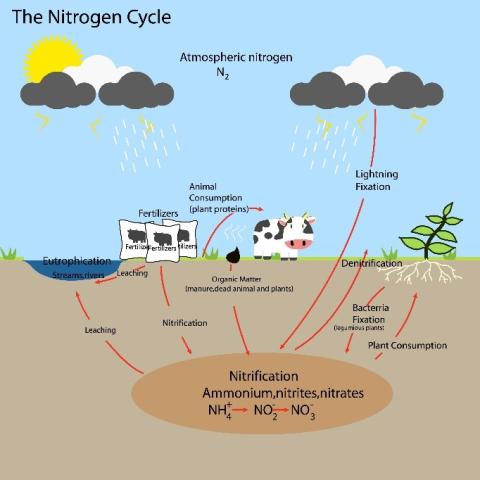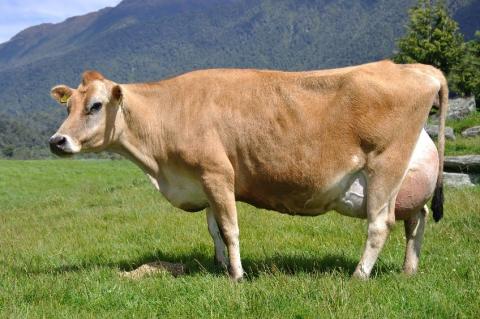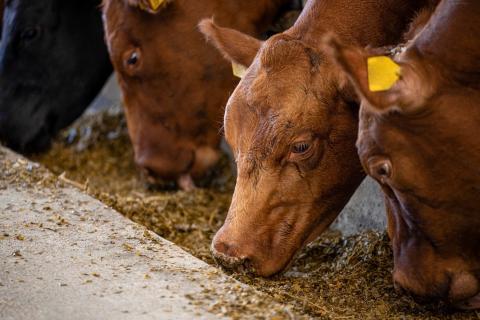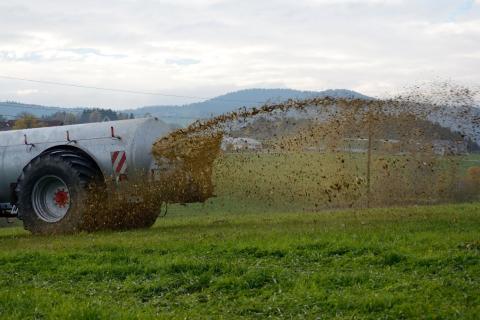Dr Saba Amir: IBERS, Aberystwyth University.
- Nitrogen utilization efficiency in ruminants is low
- Precision feeding, forage quality, feed processing, shift in nitrogen excretion from urine to faeces and reducing the amount of fermentable organic matter have the best prospects for reducing N excretion
- Methane emissions from manure can be effectively controlled by shortening storage duration, ensuring aerobic conditions or capturing the biogas in anaerobic conditions
- Direct and indirect nitrous oxide emissions are more difficult to prevent once nitrogen is excreted
- Mitigation of nitrogen losses in one form (eg. ammonia) is often compensated by nitrogen losses in other forms (eg. nitrous oxide or nitrate). These induced effects must be understood when mitigating practices are adopted
Introduction
The importance of reducing greenhouse gas emissions from livestock agriculture and nutritional strategies to mitigate enteric methane emissions in ruminants were discussed in part 1 of this technical article. This part will concentrate on decreasing nitrous oxide (N2O) emissions through nutritional strategies that reduce nitrogen (N) excretion and manure management to reduce GHG emissions. As stated in part 1, N2O has a Global Warming Potential (GWP) of approximately 265 times that of carbon dioxide but unlike methane which mainly comes from enteric fermentation, sources of N2O are both natural and anthropogenic. Even though agriculture contributes to about 68% of UK nitrous oxide emissions not all of this originates directly from livestock farming. Application of N fertilizers to enhance crop growth and yield is a significant source of added N. Livestock sources of N to grassland include urine and manure deposition on pastures and spreading of animal manures (slurry
and muck). In view of the variations in fertilizer management, manure inputs, as well as differences in soils, it is not unexpected that there is a wide degree of uncertainty on the exact levels of N2O emissions from ruminant agriculture and estimations vary substantially. Nonetheless N excreted into the environment in the form of ammonia, di-nitrogen, N2O, nitric oxide and nitrate or converted into one of these forms by soil bacteria has the potential to negatively impact air, soil and water quality. For this reason, the focus on ruminants has increased as their N utilization efficiency (ratio between N in product and N intake) is about 25% which is lower than in monogastric farm animals, while the rest of the N is mainly excreted through urine and faeces.
Nutritional strategies to reduce N excretion
Diets can have a significant effect on N losses particularly the route of N excretion in ruminants (faeces vs urine). Urinary N excretion is an important source of N2O emission. N excreted in urine can represent more than half of N losses in dairy cows. N in urine is more susceptible to N losses than N in faeces. About 60 – 90% of the excreted N in urine is in the form of urea. Urea hydrolyses rapidly upon contact with soil or faeces to ammonia. Ammonia is the substrate for aerobic microorganisms to produce nitrite, nitrate and some N2O (process known as denitrification). Nitrates are substrates for anaerobic microorganisms to produce N and again some N2O (process known as denitrification).
Secondly as stated earlier, N efficiency in ruminants is low. Although intensification of dairy farming has been accompanied by an increase in N surplus through crude protein (CP) to ensure maximum milk and protein production, N efficiency decreases with an increase in dietary N intake. With an increase in N intake, N in excreta increases rapidly and milk N efficiency drops. On reducing N intake, the proportion of faecal N increases and urine N drops. Conversely, with an increase in dietary protein the contribution of faecal N decreases and the urinary N excretion increases rapidly up to 60% of dietary N intake. The large differences in response in urinary N excretion to increased dietary N intake compared to faecal N output presents an opportunity to manipulate the diet to reduce N excretion.
Nutritional strategies to reduce N excretion
Precision feeding
In general, dietary protein levels in ruminant diets can be lowered without having an impact on productivity if they are well matched to the animal’s requirements. For example, one study reported that high protein diets were fed to cows in early lactation, improved performance but reducing the protein levels (from 173 g of CP/kg of DM to 144 g CP/kg of DM) did not affect the performance in the second half of lactation.
Ruminants are able to recycle N from the blood, primarily urea-N, to the rumen for use in microbial protein synthesis. Microbial protein also represents a significant source of amino acids absorbed in the small intestine. Ruminants can also convert dietary or endogenous non-protein N into protein-N. Hence low protein diets do not adversely affect the rumen fermentation process if recycled N replaces dietary protein N. In fact, when dietary protein is reduced, more blood urea is recycled to the rumen as opposed to being expelled in urine. Low protein diets for ruminants should be balanced for ruminally degraded protein to prevent impairment of microbial protein synthesis and fibre degradability in the rumen. The strategies for optimising dietary protein have been explored in more details in a previously published technical article https://businesswales.gov.wales/farmingconnect/news-and-events/technical-articles/how-low-can-you-go-importance-protein-dairy-cow-diet
Forages
Forage is normally the main food source for cattle. It is possible to reduce N excretion by lowering the protein content of forage while raising the carbohydrate content. A higher water-soluble carbohydrate (WSC) content in the forage causes a decrease in N intake and urinary N, due to an inverse relationship between sugar content and CP of the forages. Therefore, the beneficial effects of forages with a high WSC content appear to be a consequence of a higher energy supply at the rumen and a lower N intake. It is possible to improve WSC/CP ratio by reducing nitrogen fertilisation, increasing grazing intervals, using
selected cultivars with high sugar content or adjusting the pasture intake according to the daily patterns of WSC and CP content of the plant. For example, WSC concentration in grasses is higher at sunset than during the morning as a consequence of sugar accumulation due to photosynthesis. In theory maximising animal DMI at sunset would allow improved nitrogen utilisation.
Tannins
Tannin supplements and tanniferous forages (which have also been discussed in part 1 as a strategy to reduce methane emissions) have been shown to redirect N excreted from urine to faeces. One study reported a 9.3% reduction in urinary nitrogen due to supplementation of sheep diets with Acacia mearnsii tannins while another study stated 25% reduction. Shifting nitrogen excretion from urine to faeces by supplementing the diet with tannins or tanniferous forages can have implications on manure N availability for plant growth which may be a significant problem in agricultural systems relying exclusively on manure as a source of N for crop growth. This is because tannin-N complexes excreted in faeces are more resistant to breakdown in the soil.
Manure management options for mitigating methane and N2O emissions
The accumulation of manure in animal houses, its collection, storage, processing and application, as well as the direct deposition of manure on pasture, lead to methane, N2O and ammonia emissions. Although ammonia is not a greenhouse gas it can potentially result in indirect N2O emissions. Methane is mainly produced under anaerobic conditions during storage with very little coming from land applications. Nitrous oxide is produced directly through microbial activity under aerobic or anaerobic conditions and indirectly when manure N is lost through volatilisation as ammonia, nitric oxide and nitrogen dioxide.
The following options to mitigate GHG emissions are recommended from published studies but consideration needs to be given to their practical applicability and the cost of implementing on farms
Biofiltration
This method treats vented air from animal or manure storage houses by using biological scrubbers to turn ammonia into nitrate or biological beds to absorb ammonia. It has also been employed to reduce odours. Capturing ammonia this way can indirectly reduce N2O emissions by reducing ammonium deposition and consequent conversion to N2O. One study reported that moisture content between 48 to 52% in the biofilter media was an important factor in obtaining significant ammonia reduction and reducing N2O production. Some studies have reported that biofilters used to scrub ammonia from the exhaust streams generate N2O as a result of the nitrification and denitrification process in the biofiltration media. Therefore, N2O production in biofilter scrubbers should be considered when implementing biofiltration systems for greenhouse gas and ammonia mitigation.
Use of biofilters as a methane mitigation strategy has been investigated by a few studies although in monogastric systems. A Canadian Pork Council study reported reduction of 50 to 60% while another study reported a maximum reduction of up to 40% when contaminated air from above swine storage or from swine housing was passed through a biofiltration system. High residence time of the contaminated air is needed in these systems because the low solubility and biodegradability of methane hinders effectiveness of these filters.
Manure storage
Emissions of greenhouse gases, methane, and N2O as well as ammonia can be significant during storage. Reducing the manure storage time is one simple way to avoid cumulative greenhouse gas emissions. Another option is covering the manure stores.
Several types of manure storage covers have been reported in literature, examples include straw, wood chips, expanded clay, wood, semipermeable and sealed plastic covers. The effectiveness of manure storage cover depends on many factors including permeability thickness, degradability, porosity, and management. Semi permeable covers are valuable for reducing ammonia, methane and odour but may not be effective in reducing the net GHG emissions because they may provide conditions for reactions that subsequently release N2O. On the contrary, impermeable covers are an effective practice if the methane captured under cover is burned to produce electricity; otherwise, the captured methane would build pressure inside the storage and create an explosion hazard. Storing the manure outside in winter to reduce the manure temperature to <10 oC can mitigate methane emissions.
Manure acidification
An important factor affecting GHG emissions from stored manure is pH. In one study acidification of fresh and aged cattle manure to pH 5.5 with sulphuric acid and stored for 3 months dramatically reduced methane emission by 67- 87 % while almost completely eliminating ammonia emissions. Acidification may be a cost effective GHG mitigation practice and is not expected to greatly impact crop production. Reduction in ammonia emissions implies that manure now contains more plant-available nitrogen, which means that less acidified manure per hectare is required to meet crop N needs. The pH range of acidified manure is within the optimal range for corn and many cereal crops. Application of acidified manure to acidified soils is however not recommended. As with any chemical used on the farm it is important to adhere to instructions on the product safety data sheet to ensure correct and safe usage.
Composting
Composting has numerous advantages associated with manual handling, odour control, manure moisture and pathogen control, organic matter stabilisation and farm profitability. The main benefit of composting is that it reduces methane emissions compared with storage of manure under anaerobic conditions. However, depending on the intensity of composting ammonia losses can be particularly high reaching up to 50% of total manure nitrogen.
Similarly, the aeration of compost lowers methane emissions but can increase ammonia and
N2O losses. However even in the worst-case scenario the increase in nitrogen emissions is minimal in comparison to the benefits associated with methane reduction.
Anaerobic digestion
Anaerobic digestion is a process of degradation of organic material by bacteria in the absence of oxygen producing methane, CO2 and other gases as by-products. It is a promising strategy for mitigating methane emissions from collected manure as methane can be used as a renewable energy in the form of biogas. In addition, it also reduces pathogens and manure odour.
During anaerobic digestion N containing compounds found in substrates such as protein, amino acids and urea are reduced to ammonia. Ammonia remaining in the aqueous solution is used for crop fertilization when the digestate is applied to land. Anaerobic digestion stabilizes the organic C in the feedstock (reducing the fraction of easily degradable C in manures), improves plant availability of N and offers less energy to support the growth of N2O-forming microorganisms, reducing the potential of N2O emissions when applied to soil. Mineralization of organic N and volatile fatty acids during anaerobic digestion increases manure pH and available N, which may potentially boost ammonia volatilization. In general, the use of anaerobic manure digesters is a strongly recommended methane mitigation strategy, but careful management is necessary, so that they do not become net emitters of methane. The adoption of this type of technology on farms of all sizes may not be widely applicable and will heavily depend on financial and technical capacity, climatic conditions and availability of alternative sources of energy.
Manure application
The emissions of methane and N2O following application of manure on land are highly variable and depend on manure composition, application technique, soil type and management, soil moisture and climate. Diluting the manure or reducing the degradable C through solids separation or anaerobic digestion prior to application are options to reduce methane emissions from applied manure. As this combination of treatments reduces the availability of degradable C, it also tends to decrease N2O emissions. However, both methane and N2O emissions resulting from manure injection into soil are generally low, and therefore should be weighed against the benefits of reducing ammonia volatilization when manure is applied.
Unlike CH4, most of the N2O is produced after the manure has been applied to the soil. N2O-mitigation options for manure application include controlling the amount of N available for nitrification and denitrification (decreasing N excretion) and the availability of degradable C. Wet soils tend to promote N2O emissions, and therefore application timing, e.g. avoiding application during wet conditions or on waterlogged soils is essential.
Urease and nitrification inhibitors
Chemical additives that inhibit microbial processes that result in N2O production are known as nitrification inhibitors (NI) and those that prevent breakdown of urea to ammonium are known as urease inhibitors (UI).
NIs were found to reduce the amount of N2O emitted in intensive pasture-based systems. Up to 45% reduction was reported in a study in New Zealand when a NI (dicyandiamide inhibitor) was applied to various soils. The efficiency of NIs depends essentially on temperature, moisture and soil type. It should be noted that NIs can enhance soil ammonium and thus potentially increase ammonia losses. They have been found to be effective in reducing N2O emissions in intensive pasture-based systems.
UI are effective only when applied to urine before it is mixed with soil or faeces and therefore has limited applicability to systems where urine and faeces are not separated or separated after mixing. UIs inhibit hydrolysis of urea to ammonium and thus directly affect substrate availability for ammonia volatilization. As ammonium is a source of nitrate leaching and N2O emissions, it is expected that inhibition of urea hydrolysis will affect all three pathways of nitrogen losses in soil although this has not been consistently observed. The results of combined use of NIs and UIs have found to be inconclusive. The use of inhibitors is a promising strategy with proven environmental benefits but it may imply an additional cost to the producer.
Summary
Precision feeding and forages with high water-soluble carbohydrates have been recognized as having very good potential for reducing the amount of N excreted. Tannins or tanniferous forages on the other hand shift N excretion from urine to faeces. Reducing excreted N and shifting N excretion from urine to faeces are effective strategies for mitigating N2O emissions from manure. Among the many end-of-pipe measures available for manure management, approaches that capture methane like biofiltration or those that reduce methane emissions during storage, for example anaerobic digestion, composting and use of urease or nitrification inhibitors, are potential options. Mitigation of nitrogen losses in one form (eg. ammonia) is often compensated by nitrogen losses in other forms (eg. nitrous oxide or nitrate). These induced effects must be understood when mitigating practices are adopted. More research is needed to develop practical and economical techniques that are viable and can be widely put into practice.
For further information contact Dr Saba Amir on 01970 823 213 or email: saa143@aber.ac.uk. Alternatively visit www.gov.wales /farmingconnect







